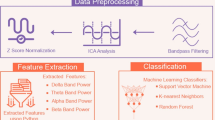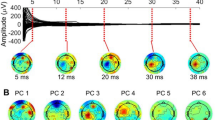Abstract
This paper discusses the theoretical foundation of Stone’s BSS (Stone in Neural Comput 13:1559–1574, 2001; Stone in Independent Component Analysis: A Tutorial Introduction, A Bradford Book, London, 2004), and it proposes a novel BSS approach based on second-order statistics of the responses of two different linear filters to source signals. The proposed approach which includes Stone’s BSS as a special case helps us to understand how generalized eigenvalue decomposition (GEVD) concludes separating vectors in Stone’s BSS. It obtains the separating vectors by simultaneous diagonalization of covariance matrices of two different linear filters responses to the mixtures. The two employed linear filters are selected dependent on source signals structures under the assumption that they have different responses to source signals. Here, two FIR filters with coefficients selected in an opposite probabilistic way have been suggested for the proposed BSS. The proposed BSS method has been compared with Stone’s BSS, SOBI and AMUSE over speech and image mixtures in different noise levels.
Similar content being viewed by others
References
Stone J.V.: Blind source separation using temporal predictability. Neural. Comput. 13(7), 1559–1574 (2001)
Stone J.V.: Independent Component Analysis: A Tutorial Introduction. A Bradford Book, London (2004)
Common P.: Independent component analysis, a new concept?. Signal Process 36, 287–314 (1994)
Haykin S.: Unsupervised Adaptive Filtering. Volume 1: Blind Source Separation. Wiley, New York (2000)
Cichocki A., Amari S.: Adaptive Blind Signal and Image Processing. Wiley, New York (2000)
Friedman J.: Exploratory projection pursuit. J. Am. Stat. Assoc. 82(397), 249–266 (1987)
DeGroot M.H.: Probability and Statistics. 2nd edn. Addison-Wesley, London (1986)
Jutten, C., Herault, J.: Independent component analysis versus PCA. In: Proceedings of EUSIPCO, pp. 643–646 (1988)
Bell A.J., Sejnowski T.J.: An information-maximization approach to blind separation and blind deconvolution. Neural. Comput. 7, 1129–1159 (1995)
Cardoso J.F.: Infomax and maximum likelihood for blind source separation. IEEE Signal Process. Lett. 4(4), 112–114 (1997)
Cardoso, J.F.: Eigen-structure of the fourth-order cumulant tensor with application to the blind source separation problem. In: Internationl Conference on Acoustics Speech and Signal Processing, pp. 2655–2658, Albuquerque, NM, USA (1990)
Belouchrani A., Amin M.G.: New approach for blind source separation using time-frequency distributions. Proc. SPIE 2846, 193–203 (1996)
Boumahdi, M., Lacoume, J.L.: Blind identification using the kurtosis: Results of field data processing. In Proceedings of the 1995 IEEE International Conference on Acoustics, Speech, and Signal Processing, volume 3, pp 1980–1983, Detroit, Michigan USA, (1995)
Jafari M.G., Vincent E., Abdallah S.A., Plumbley M.D., Davies M.E.: An adaptive stereo basis method for convolutive blind audio source separation. Neurocomputing 71, 2087–2097 (2008)
Davies, M.E., Jafari, M.J., Abdallah, S.A., Vincent, E., Plumbley, M.D.: Blind speech separation using space-time independent component analysis. In: Makino, S., Lee, T.W., Sawada, H. (eds.) Blind Speech Separation, Springer (2007)
Hyvfarinen, A.: Complexity pursuit: Combining nongaussinity and autocorrelations of signal separation. In: Proceedings of International Workshop on Independent Component Analysis and Blind Signal Separation (ICA2000), Helsinki, Finland, pp. 175–180 (2000)
Tong, L., Soon, V.C., Huang, Y.F., Liu, R.: AMUSE: A new blind identification algorithm. In Proceedings of IEEE ISCAS, pp 1784–1787 vol.3, New Orleans, LA (1990)
Molgedey L., Schuster H.G.: Separation of a mixture of independent signals using time delayed correlations. Phys. Rev. Lett. 72(23), 3634–3637 (1994)
Belouchrani, A., Amin, M.G., Abed-Meraim, K.: Direction finding in correlated noise fields based on joint block-diagonalization of spatio-temporal correlation matrices. IEEE Signal Process. Lett. 4(9), September (1997)
Belouchrani A., Meraim K.A., Cardoso J.F., Moulines E.: A blind source separation technique using second-order statistics. IEEE Trans. Signal Process. 45(2), 434–444 (1997)
Cardoso J.F., Souloumiac A.: Blind beamforming for non-Gaussian signals. IEE Proc. F (Radar Signal Process.) 140(6), 362–370 (1993)
Meraim K.A., Moulines E., Loubaton P.: Prediction error method for second-order blind identification. IEEE Trans. Signal Process. 45, 694–705 (1997)
Cichocki A., Thawonmas R.: On-line algorithm for blind signal extraction of arbiturarily distributed, but temporally correlated sources using second order statistics. Neural Process. Lett. 12, 91–98 (2000)
Choi S., Cichocki A., Belouchrani A.: Second order nonstationary source separation. J. VLSI Signal Process. 32(1–2), 93–104 (2002)
Liu W., Mandic D., Cichocki A.: Blind Second-Order Source Extraction of Instantaneous Noisy Mixtures. IEEE Trans. Circuits Syst. II: Express Briefs 53(9), 931–935 (2006)
Vaseghi, S.V.: Linear Prediction Models, chapter. 8 of Advanced digital signal processing and noise reduction,3rd edn Wiley, Ltd, (2006)
Jia, S., Qian, Y.: Improved Stone’s Complexity Pursuit for Hyperspectral Imagery Unmixing. In: 18th International Conference on Pattern Recognition (ICPR’06), vol. 4, pp. 817–820 (2006)
Stone J.V.: Blind deconvolution using temporal predictability. Neurocomputing 49, 79–86 (2002)
Martinez D., Bray A.: Nonlinear blind source separation using kernels. IEEE Trans. Neural Netw. 14(1), 228–235 (2003)
Xie S., He Z., Fu Y.: A note on Stone’s conjecture of blind signal separation. Neural. Comput. 17(2), 321–330 (2005)
Peterson G.L., Sochacki J.S.: Linear Algebra and Differential Equation. Addison-Wesley Publishing Company, Boston (2002)
Wax M., Kailath T.: Detection of signals by information theoretic criteria IEEE Trans. Acoustics Speech Signal Process. 33, 387–392 (1985)
Papoulis A.: Probability, Random Variables, and Stochastic Processes. 3rd edn. McGraw-Hill, NY (1991)
Nandi A.K.: Blind Estimation Using Higher-Order Statistics. Kluwer, Dordrecht (1999)
Waheed, K., Salam, F.M.: A data-derived quadratic independence measure for adaptive blind source recovery in practical applications. In: 45th IEEE International Midwest Symposium on Circuits and Systems, vol. 3, pp. 473–476 (2002)
Moreau, E., Macchi, O.: High-order contrasts for self-adaptive source separation, vol. 20, pp. 19–46 (1996)
Moreau E.: A generalization of joint-diagonalization criteria for source separation. IEEE Trans. Signal Process. 49, 530–541 (2001)
Author information
Authors and Affiliations
Corresponding author
Rights and permissions
About this article
Cite this article
Khosravy, M., Asharif, M.R. & Yamashita, K. A theoretical discussion on the foundation of Stone’s blind source separation. SIViP 5, 379–388 (2011). https://doi.org/10.1007/s11760-010-0161-0
Received:
Revised:
Accepted:
Published:
Issue Date:
DOI: https://doi.org/10.1007/s11760-010-0161-0




